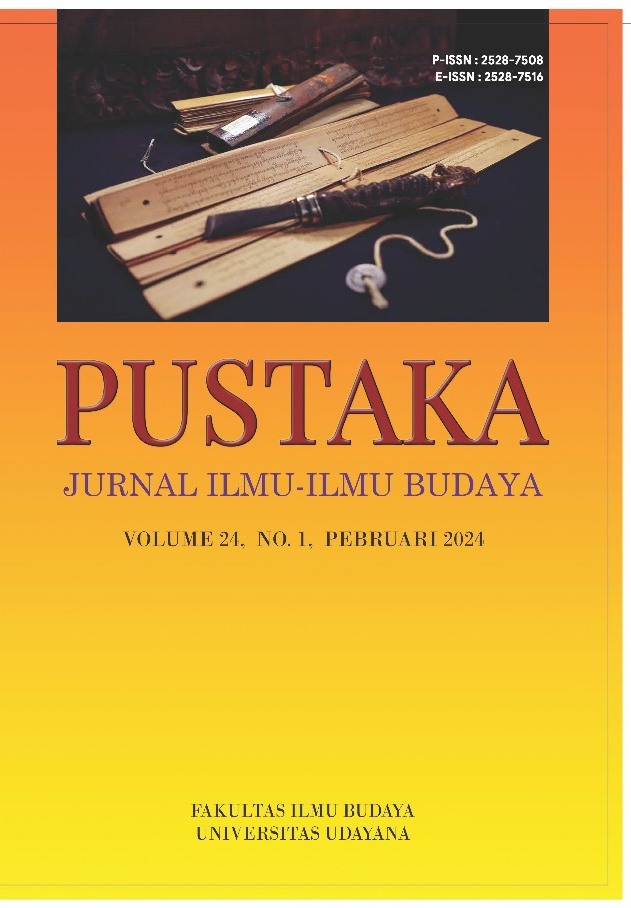Identitas Budaya Masyarakat Pulau Laut dalam Makanan Tradisional Longlek
Abstract
Cultural identity shows cultural differences from one group to another. The difference can be shown through traditional food. Not many people recognize longlek as a traditional food from Pulau Laut, Natuna. The existence of longlek is also in an unstable condition. This research aims to describe and cultural identity in longlek. This research is descriptive qualitative. The material object of this research is traditional longlek food from Pulau Laut. The formal object of this research is cultural identity. The research data sources came from longlek makers, the people of Pulau Laut, documents, activities, and perceptions concerning longlek. Data were collected using observation, interview, and literature study techniques. Informants were selected using purposive sampling method. The data analysis steps of this research are data collection, classification, interpretation, and inference. Longlek is an identity of the Pulau Laut community that is not owned by other islands in Natuna. Longlek does not only belong to the people of Pulau Laut. It should have become a communal consumption of the Natuna community. But longlek still characterizes the cultural identity of the people of Pulau Laut. Longlek is more suitable for groups that are not too crowded. This is related to its difficult material requirements. It is more suitable to be served as a special dish.
Downloads
References
Cristiana, D., & Yunaningsih, A. (2020). Edukasi Alat Dapur Tradisional Untuk Pelestarian Warisan Budaya. Altasia Jurnal Pariwisata Indonesia, 2(3), 311–316. https://doi.org/10.37253/altasia.v2i3.843
Dillenia, I., & Troa, R. A. (2017). Identifikasi Situs Kapal Karam Bersejarah “Karang Panjang” di Perairan Pulau Laut Natuna. Jurnal Kelautan Nasional, 11(1), 11–20.
Erkenning en vorming van rechtsgemeenschappen in het gewest Riouw en onderhoorigheden. (1929). Landsdrukkerij; Weltevreden.
Faruk. (2020). Metode Penelitian Sastra: Sebuah Penjelajahan Awal. Pustaka Pelajar.
Hardiansyah, M. A., Hardiansyah, M. R., & Darwis, R. (2020). Kajian Identitas Budaya Kuliner Dangke Makanan Khas Massenrempulu. Lingue : Jurnal Bahasa, Budaya, Dan Sastra, 2(1), 38–51. https://doi.org/10.33477/lingue.v2i1.1389
Nugrahani, A., & Parela, K. A. (2022). Leksikalisasi Pembungkus Tradisional Dari Daun Pisang (Kajian Etnosemantik). Alinea Jurnal Bahasa, Sastra, Dan Pengajaran, 02(02), 148–159.
Rananda, A., Jumsurizal, & Putri, R. M. S. (2023). Pengaruh Pengolahan Bahan Baku Terhadap Karakteristik Tabel Mando Ikan Tongkol (Euthynnus affinis). Marinade, 06(April), 87–96.
Riyadi, F. A., Putro, D. A., & Parantika, A. (2023). Identitas Budaya dan Kuliner Yogyakarta Sebagai Gastronomi dan Perspektif Pariwisata yang Berkelanjutan. Jurnal Ilmiah Wahana Pendidikan, 9(8), 152–161.
Syamsuddin, B. M. (2010). Cerita Rakyat dari Natuna. Pekanbaru: Yayasan Pustaka Riau.
Tijl, W. J. (1938). Van Kalme Stroomen En Verre Stranden:Levenservaring en Pluizerij. Utrecht Broekhoff N.V. v.h. Kemink En Zoon.
Tumpuan, A. (2022). Eksplorasi Potensi Wisata kuliner dalam Mendukung Perkembangan Pariwisata di Kabupaten Natuna. Journal of Tourismpreneurship, Culinary, Hospitality, Convention, and Event Management, 5(1), 41–50.
Utami, S. (2018). Kuliner Sebagai Identitas Budaya: Perspektif Komunikasi Lintas Budaya. CoverAge: Journal of Strategic Communication, 8(2), 36–44. https://doi.org/10.35814/coverage.v8i2.588
Weichart, G. (2004). Identitas Minahasa: Sebuah Praktik Kuliner. Antropologi Indonesia, 0(74), 59–80. https://doi.org/10.7454/ai.v0i74.3510










